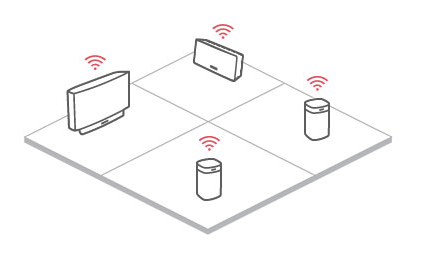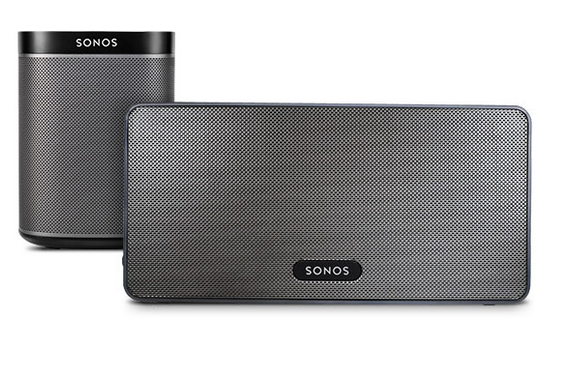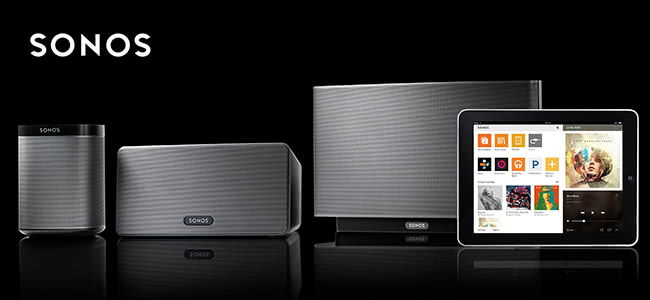Unbeknownst to those who’ve been paying more attention to the ongoing battle between downloads vs. streaming vs. physical sales, a second war has in fact been raging in the valley of music technology for some time, and that is how the music is delivered to our ears.
The competition is fierce and like any good competition, it’s resulted in some pretty staggering advancements.
Emerging out of Santa Barbara, California, one company who call themselves Sonos have proven to be the forerunner for victory in the hi-fi wars, offering consumers a sleek line of totally wireless and highly advanced audio products.
What Is Sonos?
Getting down to brass tacks, Sonos is the name of the Santa Barbara company founded in 2002 that manufactures the high-end wireless hi-fi products that bear their name, including speakers, SUBwoofers, and the patented software that acts as the engine of their entire range.
Sonos looks to equip your entire house with high-quality audio via a dedicated local Sonos network, which allows for seamless streaming of digital audio to any device that’s connected to the network, regardless of where it’s placed inside your home.
Essentially, Sonos establish a wireless network inside your home to which new Sonos devices can continually be introduced, all of them existing on the manufacturer’s proprietary peer-to-peer synchronous mesh network (the SonosNet).
In addition to being as user friendly as possible, the SonosNet allows for a tremendous amount of functionality, letting users establish zones within their respective networks, and consequently their homes, and allowing them to manipulate the audio in each zone.
Love Rage Against The Machine?
Get the latest Rage Against The Machine news, features, updates and giveaways straight to your inbox Learn more
For example, purchasing a single PLAY:1 speaker will provide you with enough power to suit your everyday audio needs — complete with wireless control from your phone or computer — but adding further devices to your home will expand the network.
Once you’ve established a network of devices throughout your home, you can isolate selections of speakers into ‘zones’. For example, you can establish a kitchen zone or a bedroom zone. You can then control the music played and the volume in each zone entirely wirelessly.
Set-Up
One of the greatest features we’ve found with Sonos is its simplicity to set up – all you need is a computer, laptop, tablet or smart phone device to download the product’s software to.
 Because we are obviously avid music fans, we want a full, engrossing sound, so we’ve got a multitude of products spread throughout our office including: The PLAY:1 and PLAYBAR speakers, SUB SUBwoofer, the CONNECT that allows us to stream music through our existing amp set-up.
Because we are obviously avid music fans, we want a full, engrossing sound, so we’ve got a multitude of products spread throughout our office including: The PLAY:1 and PLAYBAR speakers, SUB SUBwoofer, the CONNECT that allows us to stream music through our existing amp set-up.
Now, to the nitty-gritty, the actual installation process.
First, the Sonos application needs to be downloaded to whichever device/s that will be used to control the system.
From here, simply click “Add Component” where basic prompts will tell you to turn on a button on any one of the speakers, which then lead you through the registration of each speaker to the system itself. Note: this is the part where certain speakers can be set-up for different locations, for us this meant to different rooms of our office.
Once this has quickly been set-up, you can control the volume of speakers in their unique location, and you can also name each speaker for simplicity and convenience when attempting to control separate sounds within the one system.
Design
Hardware: We’re lucky enough to have three different kinds of speakers spread through the Tone Deaf, ensuring that we’ve got premium sound permeating throughout our office halls at any given time.
First up, we’ve got the PLAY:1 speaker. This badboy comes in either black or white, to which we’ve got multiple of the former. Standing at only 9cms, this slender cylinder-like speaker is small enough to be hidden, however if you dig the sound system aesethetic, it’s SUBtle, modern look makes for a feature. It may be small in stature, but the PLAY:1 packs an almighty sonic punch.
The second speaker we’ve got is the PLAYBAR. This is a much larger device that is perfectly mountable to walls. Suited to HD quality of theatre as well as music, PLAYBAR is more of your stand-alone unit, equipped with a nine speaker design that provides a full, mind-blowing sound.
Finally, we have the SUB. As the name suggests, this is the SUB-woofer, and let us warn you, when you turn this bass-master up high enough, it could crack the ground beneath you. It comes in a perfect shining black square, with part of the centre cut out, resembling a funky, new-aged type product.
 Additonally, each speaker can be managed manually, with each bearing a simple control panel including volume buttons, meaning you don’t need to have the Sonos application open in order to maintain a comfortable level of volume.
Additonally, each speaker can be managed manually, with each bearing a simple control panel including volume buttons, meaning you don’t need to have the Sonos application open in order to maintain a comfortable level of volume.
Software: The Sonos iPad app effectively puts the command centre of your entire network in your palm. The app is quick to load and user friendly, ensuring all of the options you would want in such an app are just a touch or swipe away.
Upon opening the app, you’re presented with a bisected layout. On one side, all of your sources of audio, including your own music collection and options like TV connectivity, as well as sources from the internet.
Connecting your network to a router and enabling it with internet access consequently gives you access to the entire libraries of streaming services like Spotify and Rdio, and platforms like Soundcloud and even TuneIn.
For those looking to go a little more old-school, the Sonos has connectivity options for your computer or existing hi-fi system, allowing you to play CDs and even vinyl. Amp-enabled versions of the CONNECT will even allow users to play vinyl records directly through the Sonos via RCA or mini-jack connections.
After you’ve selected your album of choice or picked out your favourite tracks — making playlists is a breeze with Sonos’ simple ‘Add to Queue’ functionality — you can manipulate the audio on the right side of the screen.
Here, you can manipulate the audio, including lowering and raising volume for the different zones in your network, as well as your standard features like infinite repeat and shuffling, as well as controlling your playlist.
For those not equipped with a tablet, Sonos once again prove the masters of convenience and user friendliness – the app is also available on your iPhone or Android device, and also has a version that will work on a laptop or desktop computer.
Performance
In testing the actual performance of each component of our particular network, we decided to select three very differing pieces of music, which would give us a good indication of how each piece handles different audio demands.
In order to see how the Sonos handles heavy bass sounds, we played James Holden’s remix of Nathan Fake’s ‘The Sky Is Pink’, to test out a dynamically produced popular rock track, we went with Rage Against The Machine’s ‘Killing in the Name’, and finally, ‘Wildlife Analysis’ by Boards of Canada, to test out ambient sounds and SUBtle variations deep in the mix of a track.
 PLAY:1: Looking at this speaker, you’d probably think there’s no way it could produce such a heavy bass sound, but boy, it definitely does. From the slow-burning, rumbling baritones of Nathan Fake’s nightmarish electronic track, the PLAY:1 creates a menacing, malevolent atmosphere reminiscent of dark underground club. The PLAY:1 does bass and electronic-based music with ease. Admittedly, these sorts of sonics are definitely more challenging to for a speaker with a 3.5inch woofer and two amps.
PLAY:1: Looking at this speaker, you’d probably think there’s no way it could produce such a heavy bass sound, but boy, it definitely does. From the slow-burning, rumbling baritones of Nathan Fake’s nightmarish electronic track, the PLAY:1 creates a menacing, malevolent atmosphere reminiscent of dark underground club. The PLAY:1 does bass and electronic-based music with ease. Admittedly, these sorts of sonics are definitely more challenging to for a speaker with a 3.5inch woofer and two amps.
This was the are that we felt most confident with the PLAY:1, and rightfully so. Using Rage Against The Machine’s ‘Killing In The Name Of’, the small speaker handles the multitude of sound exploding from its insides seamlessly, from the clear-cut guitar licks, the crashing percussions and vocals, not an element of sound is missing. And don’t worry, you can crank this little speaker as high as you want – it will deliver.
Okay, onto our ambient example, this is where we were most skeptical. Can a pint-sized speaker really do justice to an ambient, higher-toned instrumental piece? Yes, it can. By turning the volume to its tiptop highest point, the sleepy sounds of Board of Canada flowed beautifully from the speaker with little to zero distortion at all.
PLAYBAR: Considering Sonos push the Soundbar as a go-to option for consumers looking to soup-up their home theatre experience, the PLAYBAR poses some interesting pros and cons for lovers of music, though nothing that would act as a deterrent.
The width of the soundstage generated by the PLAYBAR is impressive and it provides a satisfactory amount of detail and weight, as well as a tonal balance you won’t get from standard speakers or soundbars.
That said, playing through our test tracks, we noticed that the speaker excels when it comes to ambient sounds as well as highly compressed pop and rock tracks, with every SUBtlety coming through the system, but not to the same degree with low-end tones.
The sound overall is more atmospheric, which is understandable, as it’s intended to compliment a home theatre system. That said, it still packed a hell of a punch when we played ‘The Sky Was Pink’ through it, and complimented by the SONOS SUB, you’ll never hear any complaints form bass heads.
 Sonos iPad App: Considering everything from your refrigerator, to your air-conditioning system now comes with a proprietary app, it’s almost expected that something like the Sonos could be commandeered via an app or piece of software.
Sonos iPad App: Considering everything from your refrigerator, to your air-conditioning system now comes with a proprietary app, it’s almost expected that something like the Sonos could be commandeered via an app or piece of software.
However, much like the hardware, the Sonos software exceeds expectations and in some cases, what conventional wisdom would dictate are the limitations for a piece of software, providing users with an easy-to-use command centre for their network.
The iPad app is, for all intents and purposes, pretty much crash-proof, and that’s even with other apps running in the background. Indeed, the Sonos app will keep streaming music through to your network as you carry on with other activities on your device.
The app’s connectivity with services like Spotify and Rdio is a breeze, offering users and easy search function — you can search for artists, albums, and individual tracks — that will yield results from all of the connected platforms.
The Sonos app also allows you to make new additions to your network with a single press, as well as controlling the zones established on your network, and each feature is easy to find, meaning you won’t spend hours fiddling with an unyielding Settings menu.
Final Verdict
While the hi-fi wars will most likely rage on, Sonos will no doubt continue to have that enviable combination of high-end engineering and user-friendly design, providing users with the best performance you’re likely to get out of a wireless speaker system, and with an extensive range of products available, your Sonos network is as big or small as you want it to be, ensuring the system is truly the complete package.
For more info on the Sonos system check out www.sonos.com




































